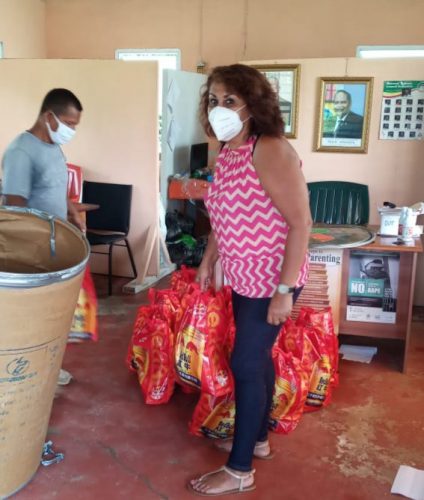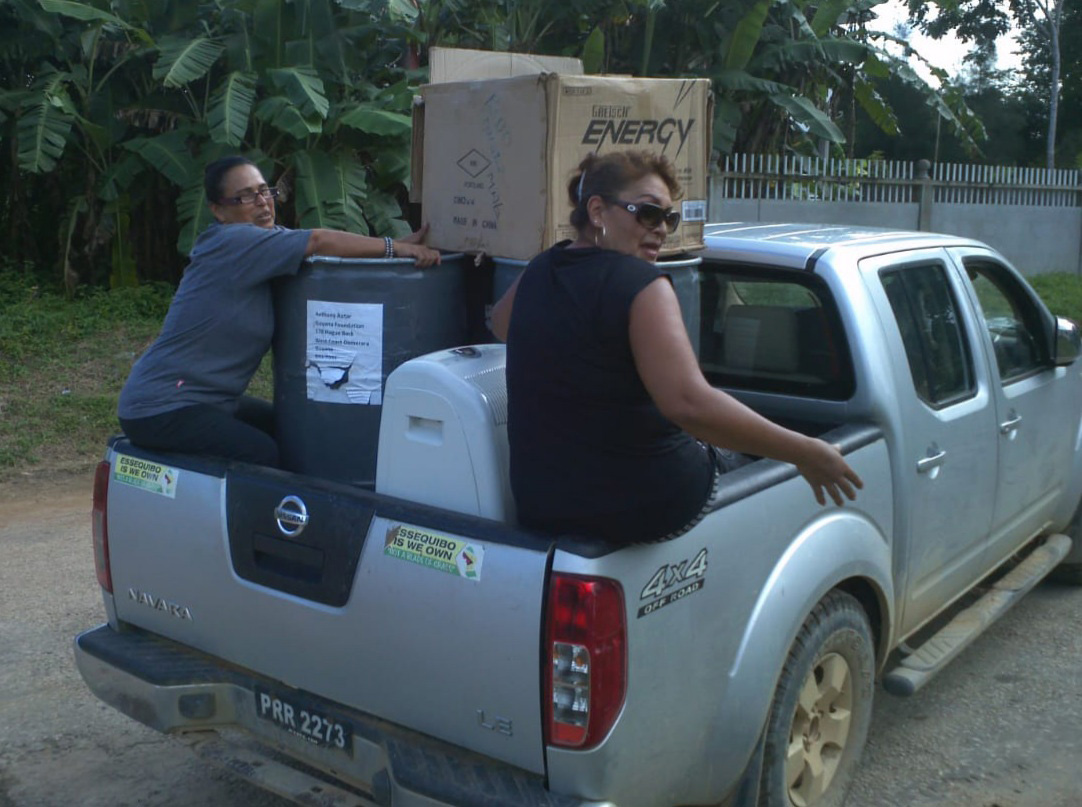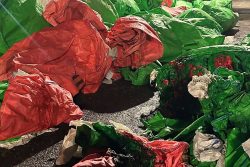As she gets set to exit office, Santa Rosa Toshao Whanita Phillips is closing another chapter in a working life that to date has been mainly voluntary.
“I never worked at a paid full-time job, but I am satisfied that in spite of opposition I have contributed to the welfare of the people and the development of the community where I was born,” Phillips told Stabroek Weekend in a recent telephone interview.
The third female to hold the office of Toshao of the largest Indigenous Peoples village in Guyana, Phillips began her life of voluntary service in the early 80s following a national Mashramani costume pageant she took part in as a representative of Region One (Barima-Waini).

It started when she stepped off a domestic Guyana Airways Corporation flight at Bemichi Airstrip, Santa Rosa, in 1982, when local administrative officials who were there asked her if she wanted to take part in a pageant in which a delegate was being sought to represent Region One.
“But before being selected I had to compete against the candidates from Mabaruma and Matthew’s Ridge. I beat them out. A lot of focus was placed on the costumes, symbolism, design, presentation, etc. The competition was held at Albion, Corentyne. I was adjudged the first runner-up. Region Nine won the competition. It was a good experience that gave me a good grounding in seeing the beauty of our culture, our people and the environment.”
Phillips, who was born in Santa Rosa, was raised from the age of eight months by her grandmother, Juanita Daniels, of Maturin. She later attended Charlestown Secondary School, where she joined her mother, a registered nurse working in Georgetown.
On her return to Santa Rosa following her secondary education in the city and her involvement in the Mashramani pageant, Phillips got involved in the activities of the parish of Santa Rosa Roman Catholic Church.
“At the time, Fr George Vanderwood was the priest-in-charge, and St John’s Day, observed on 24th June, was a big event in the parish’s calendar.” St John’s Day marked the arrival of the first Roman Catholic priest, Fr William Hynes, to the area. It was said he travelled from Trinidad through Georgetown to Moruca to meet the spiritual needs of the people who wanted a priest stationed in the area. Each year until the COVID-19 pandemic struck, Fr Hynes’ arrival was reenacted at the break of St John’s Day with much celebration, including mass followed by a number of sporting activities. The activities included boat races, boat tug-o-wars and swimming.
Under Fr George’s direction, Phillips, whose placement in the Mashramani pageant was welcomed in the Moruca sub-region, pulled off the first, costume/ beauty pageant at a St John’s Day of activities as part of a cultural event to raise funds for the church. The renovation of the century-old wooden Santa Rosa Church is an ongoing activity.
“The delegates in the pageants would not only model their outfits but they had to show community spirit. In the competitive events, the delegates had to be the main cheerleaders bearing the flags of the areas they represent. Organising pageants was how my community service evolved,” she said with laughter in her voice.
In 2005, when then Labour Minister Manzoor Nadir challenged the community to organise a Moruca Expo, the Santa Rosa Village Council took up the challenge to host it and Phillips was asked to be part of the organising committee and to be responsible for organising a Miss Moruca Expo pageant involving young women from all the villages in the sub-region. Moruca Expo has since become a fixture and fundraiser on the Santa Rosa Village’s annual calendar.
“The exposition features competitions that would show visitors to the village our daily cultural activities, like how we process the bitter cassava to get cassava bread and cassareep. How to use the mucru to make quakes, sifters and matapees among other utility craft. It showcases our agricultural produce, craft, and beverages among other stuff. The sporting competitions, like the archery competition among men and women, are also entertaining and competitive.”
PTA service
The mother of seven children, Phillips was an active member of the parent–teacher associations (PTAs) of both Santa Rosa primary and secondary schools. She served on the executive committee of both schools, eventually becoming the chairman of the Santa Rosa Secondary School (SRSS). She served on the secondary school’s PTA for three consecutive two-year terms between 2010 and 2017.
Phillips said she was skeptical of accepting the position of PTA chairman of the school, which has an enrollment of over 700 children and over 30 teachers.
“I took on the challenge. Our committee really worked hard. Together with other parents we embarked on fund-raising drives. We were ably assisted by corporate citizens, charitable organisations and individuals, including our own sons and daughters of Moruca now residing overseas, and friends from abroad. Together our donors helped us to meet several of the school’s needs including providing computers to open a computer laboratory and books for the secondary school library. We got stationeries for the school’s administration, and curtains, sheets and blankets for the students living in the dorms. Among our donors were AGM Inc/Guyana Gold-fields, Guyana Foundation, and overseas based friends Gary Wills, Lisa Bourdages and Stephanie Walls. We also helped Manawarin Primary School with donations of books and other learning material in the sum of $1 million.”
To ensure that SRSS always had funds, Phillips said, “PTA member Yvonne Vieira, who can really cook, and I got food handlers certificates and we cooked food and sold. We also did bar-b-ques and hot dogs.”
As chairman of the school’s PTA and with the experience she had gained in the staging of pageants, Phillips along with “very enthusiastic teachers” organised and staged for two consecutive years the ‘Miss Santa Rosa Secondary School Queen’ pageant.
“That was a success and they were good fund-raisers for the school. After I left as chairman it was discontinued. I was fortunate to have worked with very supportive head teachers like Nigel Richards, Glenn De la Cruz and Marti De Souza.”
Channeling energies
“My first child was born with a disability and she died in late 2017. So I did all the volunteering while tending to her and my other six children. So when other parents said they could not volunteer, sometimes I had to tell them of my circumstances.”
With the death of her eldest child, Phillips was devastated. Her eldest child died several months before the nomination of candidates to elect a toshao of the village for another three-year term.
“Some people who knew of my work as PTA chairman asked me to contest the toshao elections. I was grieving the loss of my daughter. I didn’t know what to do. My husband, Henry, who has been supportive of me in all I have been doing, encouraged me to contest the election. He felt that working and helping the community would take my mind of our family’s loss while doing a good cause and so I took part.”
Phillips campaigned with her band of supporters and won the elections from her nearest opponent by 154 votes.
“I knew the office of Toshao was going to be challenging but I didn’t expect it to be so challenging that I would be the subject of misinformation and protests by elements opposed to what the village council and I were trying to do in the interest of the village during the Covid-19 pandemic.”
Phillips began her tenure eager to hit the ground running and in earnest. She wanted to continue and complete the work that had begun under the previous village administration.
“You can say we got 18 months out of the three-year term to get some things done. The span of the Kumaka/San Jose Bridge was completed under my watch but there is still work to be completed on the dams on both sides of the river. People had been clamouring for a proper bridge for years. The Bemichi Airstrip, one of the best airstrips in the hinterland, was also completed under my watch.”
“I took over a village office, which the new council had to try to refurbish and make habitable. We put in brand new windows, repainted the building and installed a water dispenser. We also set up a kitchenette. We bought a generator for the village office in case of emergencies. We had to put systems in place to preserve some of our more important records.”
Her office also inherited a number of unresolved land issues, some of which had been pending for many years. “I tried as best as possible to resolve as many. Some were not popular but decisions had to be made.”
The construction of a mall to replace the old market building was under construction when she took over. “Some people told me I could not get it done and it would be a white elephant. With each of the 11 areas that make up the village donating $1 million each and with a $10 million grant from the then Ministry of Indigenous Peoples’ Affairs, the facility… has been completed and all 48 stalls are now fully occupied.”
Another achievement, she said, was the establishment of a fish and meat market. “We have that now.”
Santa Rosa has a population of over 12,000 people and is divided into 11 areas for which a councillor has responsibility. She commended the councillors for ensuring the construction of multipurpose buildings in their areas where they are needed.
When the new toshao and council take office, Phillips said, “They will be getting a mobile vehicle for the office to carry out its work. When I took office, the village council’s vehicle was parked up and had no tyres. Some parts were also needed to get it road worthy. My husband, being a motor mechanic, worked on it and little by little he managed to get it up and running. It has now been operational for over two and half years. The new toshao and council will inherit a working vehicle.”
Consequences of national politics and COVID-19
Like the rest of the country, she said, “We suffered the consequences of the no-confidence motion which brought political uncertainty to our village and sub-region. Santa Rosa is both politically and religiously sensitive. The no-confidence motion was followed by politicking and campaigning, the prolonged general and regional elections, and the outbreak of coronavirus.”
The outbreak of COVID-19, she said, was one of the most challenging times of her tenure. Santa Rosa was the first village to impose a lockdown following the first case detected in the village. “We had three lockdown sanctioned by the Ministry of Public Security. People were not happy about the lockdown and many said the coronavirus was not real. They blamed me for the lockdown and basically everything. Even though we tried as hard as possible to get the message out that the virus was real, some elements held two protests against me and called for my removal. That was during the period when Santa Rosa was the epicentre of the pandemic in the country. At the height of the pandemic in the early days, we had 96 cases. Though I can’t say how many cases we have recorded to date, I know we have had six deaths.
“I worked really hard during that period. In the nights I had to attend the COVID-19 Task Force meetings, which included the doctors who were tending to patients who had been tested positive. I had to take two tests. Thank God, I was tested negative both times.”
Phillips coordinated relief supplies that were sent to her by non-governmental organisations for residents, and to COVID-19 patients in isolation for the Civil Defence Commission. At one time, when her daughter was tested positive for the virus, Phillips herself had to be quarantined and still coordinate from her home the distribution of some supplies which were at the village office. She also handed over supplies to some people who were in quarantine and to some in isolation.
She said, “I was heavily criticized by some who felt I was favouring some people over others but the supplies were not for everyone. They were for the more vulnerable and those affected directly.”
She continued, “It was not easy. I had to deal with people panicking, when I, too, felt like panicking.”
When people were being asked to stay home, wear masks and socially distance themselves to avoid contracting the deadly disease, Phillips said, she had to travel to meet with the police and Coast Guard at Charity on the Pomeroon River to seek their assistance in setting up a station at Moruca Mouth to monitor boats and ensure that operators were complying with the COVID-19 protocols.
She is satisfied, she said that unlike the period when people were not wearing masks, lots of people are adhering to the protocols today.
And though she did not run for a second term as toshao, she said, “I am also satisfied that despite personal health issues, I gave of my best. I will not stop helping anyone who comes to me for help.”










